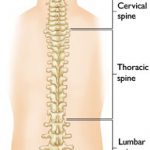Introduction to the anatomy of the human spine
The vertebrae- building blocks of the human spine
The Human Spine is made up of the Vertebral bones (Vertebrae), these are the building blocks of the Spine.
The Vertebrae are divided into 7 Cervical Vertebrae (Neck region), 12 Thoracic Vertebrae (Chest region), 5 Lumbar Vertebrae (Lower Back region) and the Sacrum and Coccyx (Base of the Spine region).
Intervertebral discs
Between each Vertebra is an Intervertebral Disc. This is made of firm but elastic tissue which acts as a shock-absorber, cushioning the Spine during normal movements.

Facet joints
Between each Vertebra are a pair of small joints, the Facet Joints. These allow the spine to articulate, allowing the spine to bend.
The spinal cord
The Spinal Cord runs in the middle of the Vertebrae in the Vertebral Foramen, which protects it. The Spinal Cord sends off nerve branches at each Vertebral level.
Nerve roots
These Nerve Branches or Nerve Roots travel to respective areas of the body, supplying innervation for sensation, motor function and pain.
Membranes surrounding the spinal cord
The Spinal Cord is also protected by a fluid-filled sac, surrounded by different membrane layers.
These layers include the Pia Mater, Arachnoid Mater and Dura Mater which surround the Spinal Cord, within the Vertebral Foramen. Just outside the Dura Mater is the Epidural space.



